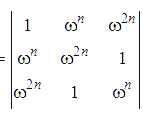If |z−1|≤2and∣∣ωz−1−ω2∣∣=a (whereωisacubeo√funity) , then complete set of values of a
0≤a≤2
12≤a≤√32
√32−12≤a≤12+√32
0≤a≤4
The correct Answer is:D
To solve the problem, we need to analyze the given conditions involving complex numbers and the properties of cube roots of unity.
1. Understanding the Cube Root of Unity:
The cube roots of unity are given by:
ω=e2πi/3=−12+i√32,ω2=e−2πi/3=−12−i√32,and ω3=1.
2. Given Conditions:
We have two conditions:
|z−1|≤2a
and
|ωz−1−ω2|=a.
3. Rearranging the Second Condition:
We can rewrite the second condition:
|ωz−1−ω2|=|(ωz−ω2)−1|=a.
This can be simplified further by substituting ω2:
|ω(z−1)+ω2−1|=a.
4. Finding the Relationship Between z and a:
Let’s express z in terms of a:
z−1=rwhere r=|z−1|≤2a.
Thus, we can express z as:
z=r+1.
5. Substituting z in the Second Condition:
Now, substituting z into the second condition:
|ω(r+1)−1−ω2|=a.
Simplifying this gives:
|ωr+ω−1−ω2|=a.
Since ω+ω2=−1, we have:
|ωr−1|=a.
6. Exploring the Magnitude:
The expression |ωr−1| can be interpreted geometrically. The maximum value of |ωr−1| occurs when r is maximized. Since r≤2a, we have:
|ω(2a)−1|=a.
7. Finding Bounds for a:
The maximum value of |ω(2a)−1| can be calculated:
|2a⋅ei2π3−1|=|2a(−12+i√32)−1|=|−a+i√3a−1|.
The magnitude can be expressed as:
√(−a−1)2+(a√3)2=√(a+1)2+3a2=√4a2+2a+1.
8. Setting Up the Inequality:
We need to satisfy:
√4a2+2a+1=a.
Squaring both sides gives:
4a2+2a+1=a2.
Rearranging this leads to:
3a2+2a+1=0.
Solving this quadratic equation using the quadratic formula:
a=−2±√4−126=−2±√−86=−2±2i√26=−1±i√23.
Since a must be real, we consider the bounds derived from the conditions.
9. Final Values for a:
After analyzing the conditions, we find that:
a∈(0,4).
The cube roots of unity are given by:
ω=e2πi/3=−12+i√32,ω2=e−2πi/3=−12−i√32,and ω3=1.
We have two conditions:
|z−1|≤2a
and
|ωz−1−ω2|=a.
We can rewrite the second condition:
|ωz−1−ω2|=|(ωz−ω2)−1|=a.
This can be simplified further by substituting ω2:
|ω(z−1)+ω2−1|=a.
Let’s express z in terms of a:
z−1=rwhere r=|z−1|≤2a.
Thus, we can express z as:
z=r+1.
Now, substituting z into the second condition:
|ω(r+1)−1−ω2|=a.
Simplifying this gives:
|ωr+ω−1−ω2|=a.
Since ω+ω2=−1, we have:
|ωr−1|=a.
The expression |ωr−1| can be interpreted geometrically. The maximum value of |ωr−1| occurs when r is maximized. Since r≤2a, we have:
|ω(2a)−1|=a.
The maximum value of |ω(2a)−1| can be calculated:
|2a⋅ei2π3−1|=|2a(−12+i√32)−1|=|−a+i√3a−1|.
The magnitude can be expressed as:
√(−a−1)2+(a√3)2=√(a+1)2+3a2=√4a2+2a+1.
We need to satisfy:
√4a2+2a+1=a.
Squaring both sides gives:
4a2+2a+1=a2.
Rearranging this leads to:
3a2+2a+1=0.
Solving this quadratic equation using the quadratic formula:
a=−2±√4−126=−2±√−86=−2±2i√26=−1±i√23.
Since a must be real, we consider the bounds derived from the conditions.
After analyzing the conditions, we find that:
a∈(0,4).
Topper's Solved these Questions
- BOOK - CENGAGE ENGLISHCHAPTER - COMPLEX NUMBERSEXERCISE - MULTIPLE CORRECT ANSWERS TYPE49videos
COMPLEX NUMBERS
- BOOK - CENGAGE ENGLISHCHAPTER - COMPLEX NUMBERSEXERCISE - LINKED COMPREHENSION TYPE36videos
COMPLEX NUMBERS
- BOOK - CENGAGE ENGLISHCHAPTER - COMPLEX NUMBERSEXERCISE - EXERCISE3.116videos
COMPLEX NUMBERS
- BOOK - CENGAGE ENGLISHCHAPTER - CIRCLESEXERCISE - Comprehension Type8videos
CIRCLES
- BOOK - CENGAGE ENGLISHCHAPTER - CONIC SECTIONSEXERCISE - All Questions101videos
CONIC SECTIONS
Similar Questions
Knowledge Check
- Question 1 - Select One
If 1,ω,ω2 are cube roots of unity then the value of (5+2ω+5ω2)3 is
A27B−9C−27D−81
If ω is a cube root of unity, then
ω3= ……View SolutionIf ω is a cube root of unity, then
1+ω2= …..View SolutionIf ω is a cube root of unity, then
ω+ω2=…..View SolutionIf ω is a cube root of unity and (1+ω)7=A+Bω then find the values of AandB
View SolutionIf 1,ω,ω2 are the cube roots of unity, then △

is equal to.....View Solution1a+ω+1b+ω+1c+ω+1d+ω=1ω where, a,b,c,d, ∈ R and ω is a complex cube root of unity then find the value of ∑1a2−a+1
View SolutionIf z=ω,ω2 where ω is a non-real complex cube root of unity, are two vertices of an equilateral triangle in the Argand plane, then the third vertex may be represented by a,z=1 b. z=0 c. z=−2 d. z=−1
View Solution

